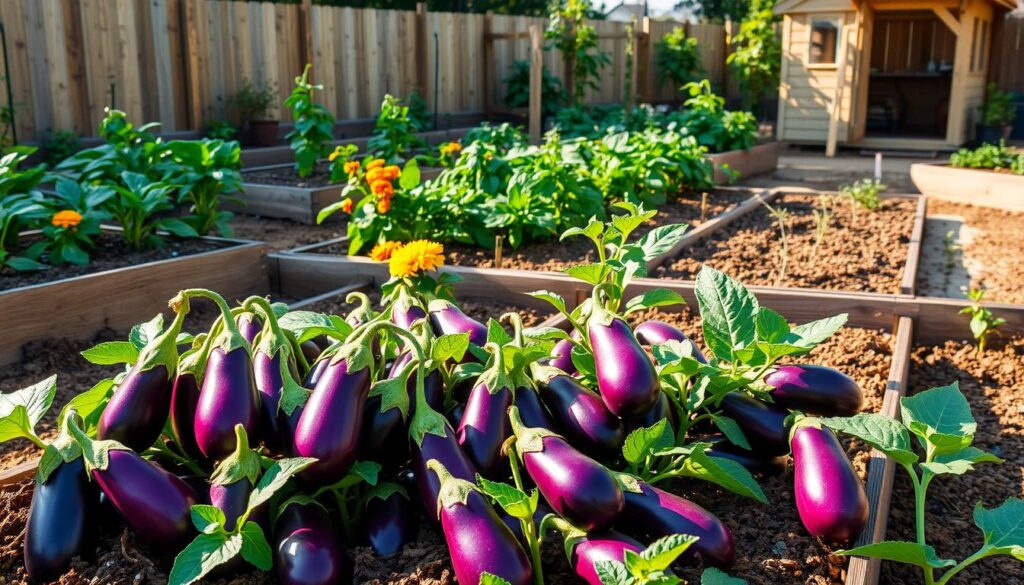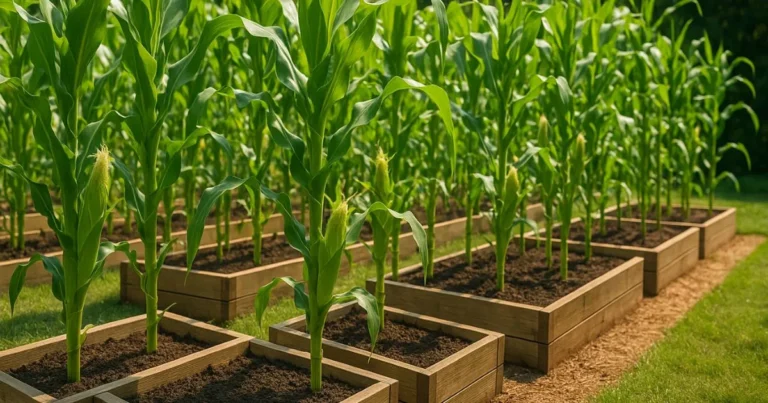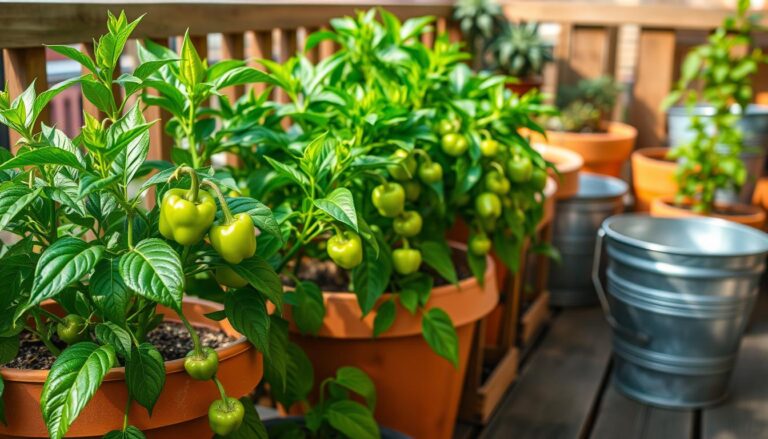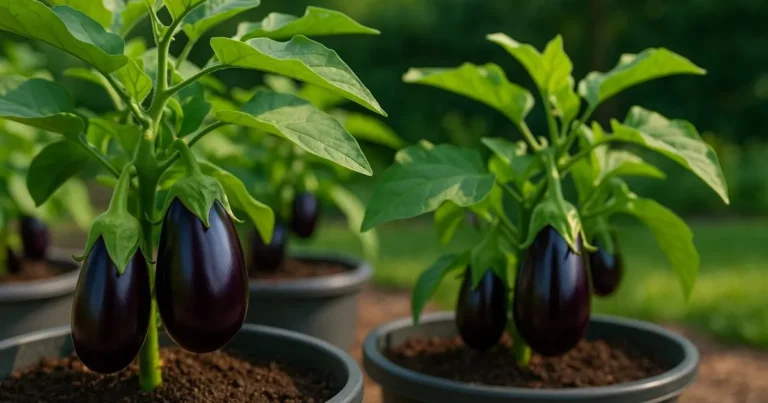Growing Eggplant: A Complete Guide for Beginners

Table of Contents
Growing Eggplant: A Complete Guide for Beginners
Are you interested in cultivating eggplant in your garden? Eggplant grows best in warm weather. It’s part of the Nightshade family, like tomatoes and peppers.
Starting out with growing eggplant can be tough. But with the right tips, you can succeed. This guide will help you learn how to grow eggplant, from the basics to advanced techniques.
Follow this guide to become an expert in eggplant cultivation. Let’s start!
Understanding Eggplant: Varieties and Characteristics
When growing eggplant, knowing the different types is key to a good harvest. Eggplant comes in many shapes, sizes, and colors. This makes it a great choice for gardeners at home.
Popular Eggplant Varieties for Home Gardens
Home gardeners love certain eggplant varieties for their taste and growth. ‘Black Beauty’, ‘Black Magic’, and ‘Fairy Tale’ are favorites. ‘Black Beauty’ has big, dark purple fruit. ‘Fairy Tale’ gives you lots of small, tender eggplants.
Growth Habits and Plant Characteristics
Eggplants grow as annuals in North America and need warm weather. They spread out a lot and can get big. So, they need support like stakes or trellises to grow well.
Climate Requirements for Different US Growing Zones
Eggplant loves warm weather, between 65°F and 85°F (18°C to 30°C). In the US, the best time to plant eggplant changes with the region. Wait until after the last frost and when the soil is warm.
| US Growing Zone | Ideal Temperature | Planting Time |
|---|---|---|
| 3-5 | 65-75°F (18-24°C) | Late Spring |
| 6-8 | 70-80°F (21-27°C) | Early Summer |
| 9-11 | 75-85°F (24-30°C) | Year-round |
Benefits of Growing Your Own Eggplant
Growing your own eggplant brings many benefits beyond the garden. It improves your health, saves money, and enhances your cooking. It’s a rewarding hobby that offers several advantages.
Nutritional Value and Health Benefits
Eggplants are packed with antioxidants, fiber, and vitamins. They’re great for your diet. By growing your own, you get fresh, nutritious food right in your backyard. This can boost your health and well-being.
Cost Savings and Sustainability
Growing eggplant saves you money compared to buying it. It also helps the environment by reducing reliance on industrial farming. This approach lowers your carbon footprint and supports green practices.
Flavor Advantages of Home-Grown Eggplant
Home-grown eggplant tastes better than store-bought. Its freshness and peak ripeness make it more flavorful. You can use it in many dishes, like eggplant parmesan or grilled eggplant salads.
Planning Your Eggplant Garden
To get a great harvest, planning your eggplant garden is key. You need to know when to plant, how to arrange your garden, and what tools you’ll use.
Seasonal Timing for Different US Regions
Eggplant loves warm weather, above 70°F (21°C). In most US areas, plant eggplant outside in late spring to early summer, after the frost. In warmer places like Southern states, you can start planting in late winter.
Space Requirements and Garden Layout
Eggplants need full sun and well-draining soil. Plant them 18-24 inches apart, with rows 30-36 inches apart. This spacing helps with air flow, preventing disease.

Tools and Supplies Needed
You’ll need basic gardening tools to start. These include a shovel, trowel, watering can, and stakes for support. Here’s a simple table of the essential tools and supplies:
| Tool/Supply | Purpose |
|---|---|
| Shovel/Trowel | Planting and soil preparation |
| Watering Can/Hose | Watering plants |
| Stakes/Trellis | Supporting plant growth |
By planning your eggplant garden with these tips, you’ll be ready for a successful harvest.
Essential Requirements for Growing Eggplant Successfully
To grow eggplant well, you must give it the right conditions. This means knowing about sunlight, temperature, soil, and water needs.
Sunlight and Temperature Needs
Eggplants need lots of sunlight to grow. They should get at least 6 hours of direct sunlight per day. They also do best in temperatures between 70°F and 85°F.
Temperatures outside this range can harm the plant. It might grow less or get damaged.
Soil Requirements and Preparation
The soil for eggplant should drain well and be fertile. Eggplants like a soil pH between 5.5 and 7.5. To make the soil better, add compost or well-rotted manure.
- Test your soil pH and adjust it if necessary.
- Add compost or well-rotted manure to improve soil fertility.
- Ensure the soil is well-draining to prevent waterlogged conditions.
Water and Humidity Considerations
Eggplants need consistent moisture, specially when they’re producing fruit. But, they don’t like waterlogged soil. Keeping the air around them moderately humid helps prevent disease.
Some key things to remember include:
- Water the plants deeply but not too often to help roots grow deep.
- Don’t water from above to avoid fungal diseases.
- Keep the soil moisture level steady.
Starting Eggplant from Seeds
Start eggplant seeds indoors for a head start on the growing season. This gives your plants a strong start and a longer growing season.
When to Start Seeds Indoors
Start eggplant seeds indoors 6-8 weeks before the last frost date. This lets seedlings grow strong enough for outdoor planting when it’s warmer.
Seed Starting Techniques and Materials
You’ll need seed trays or small pots, quality seed starting mix, and a warm, light spot. Use a heating mat to keep soil at 75-85°F (24-29°C) for germination. Plant seeds ¼ inch deep and keep the soil moist.
Caring for Seedlings
After germination, ensure seedlings get adequate light to avoid becoming leggy. Keep the soil moist but not too wet, and keep it warm. As they grow, transplant them into bigger containers for more room.
By following these steps, you’ll grow healthy eggplant seedlings. They’ll be ready to thrive in your garden.
Transplanting and Direct Sowing Methods
Transplanting eggplant seedlings or directly sowing seeds is a big step in their growth. It’s important to think about timing, technique, and the environment. This ensures a healthy and productive crop.
Proper Timing for Transplanting
The best time to move eggplant seedlings outside is when they’re 6-8 inches tall. Wait until the weather is warm and the soil is ready. Warm soil is crucial for eggplant growth, helping roots and the plant overall.
Hardening Off Process
Before moving seedlings outside, you need to harden them off. This means slowly getting them used to outdoor conditions over 7-10 days. Start by placing them in a shaded area for a few hours, then gradually increase sunlight and wind.
- Begin with shade and gradually move to partial sun.
- Increase exposure time daily.
- Monitor seedlings for signs of stress.
Spacing and Planting Depth Guidelines
Spacing is key for eggplant growth. Plant them 18-24 inches apart in rows 30-36 inches apart. This helps with air circulation and prevents disease. Plant at the same depth as their pots or slightly deeper. Water well after planting.

Direct sowing is also good, mainly in warmer places where soil warms fast. Sow seeds ¼ inch deep and 2-3 inches apart. Thin seedlings to the right spacing when they’re a few inches tall.
Container Gardening Techniques for Eggplant
If you’re short on space but want to grow eggplant, try container gardening. It’s a great way to enjoy this tasty veggie, even with little room.
Choosing the Right Containers
When picking containers for eggplant, size and drainage matter a lot. Choose ones that are at least 5-gallons to give roots room to grow. Make sure they have holes for water to drain out to avoid root rot.
Special Soil Mix for Container Eggplants
A good potting mix is key for container-grown eggplants. Mix peat moss, perlite, and vermiculite for a blend that holds moisture but drains well. This mix helps prevent root diseases.
Maintenance Differences for Container Plants
Container eggplants need more water and food than those in the ground. Check the soil daily and fertilize every two weeks with a balanced fertilizer. This helps them grow strong and produce lots of fruit.
By using these container gardening tips, you can grow eggplant in containers and get a big harvest.
Caring for Growing Eggplant Plants
As your eggplant plants grow, they need consistent care to thrive. This care includes several key elements. These elements help promote healthy growth and fruit production.
Watering Techniques and Schedule
Eggplants need consistent moisture, more so when they’re producing fruit. Water them deeply once or twice a week, based on the weather. Aim for about 1-2 inches of water per week, from rain or irrigation. Make sure not to get water on the leaves to avoid fungal diseases. Water at the soil level instead.
Fertilizing Requirements and Timeline
Fertilization is key for eggplant plants. Use a balanced fertilizer (like 10-10-10 NPK) when planting. Then, use a high-phosphorus fertilizer (like 15-30-15 NPK) when the plants start flowering. This helps with fruiting and overall health.
Pruning and Support Systems
Pruning and support are crucial for eggplant plants. Remove lower leaves to prevent soil-borne diseases. Provide support with tomato cages, trellises, or stakes to keep plants upright and encourage fruiting. Prune the plant for good air circulation, which prevents disease.
By following these care guidelines, you’ll enjoy a healthy and productive eggplant harvest. “Consistency is key when it comes to caring for eggplant plants,” gardening experts say. Proper care will lead to a bountiful harvest of delicious eggplants.
Organic Eggplant Farming Methods
To grow eggplant organically, you must learn about organic farming. It focuses on natural methods and being sustainable. Organic farming for eggplant means using natural fertilizers and managing pests without chemicals.
Natural Fertilizers and Soil Amendments
Keeping the soil healthy is key for eggplant growth. Compost, manure, and green manure are great choices. Compost boosts soil’s nutrient levels and structure.
Manure adds important micronutrients. Green manure crops like clover and rye help with weed control and add organic matter.

Chemical-Free Pest Management
It’s important to manage pests without chemicals in organic farming. Crop rotation helps break pest cycles. Biological control, like introducing beneficial insects, is also effective.
Companion planting is another good strategy. It involves planting certain plants to keep pests away from eggplants.
Sustainable Growing Practices
Organic farming also includes sustainable practices. Mulching keeps the soil moist and weeds away. Drip irrigation saves water and cuts down on evaporation.
| Practice | Benefit |
|---|---|
| Compost Use | Improves soil fertility and structure |
| Crop Rotation | Reduces pest and disease pressure |
| Drip Irrigation | Conserves water and reduces evaporation |
Managing Common Pests and Diseases
A successful eggplant harvest depends on managing pests and diseases well. It’s key to keep your plants healthy and get a good yield.
Identifying and Controlling Insect Pests
Eggplant faces many insect pests like flea beetles, aphids, and hornworms. It’s important to watch your plants closely for signs of pests. Use organic or integrated pest management (IPM) strategies to fight these pests. This can include introducing helpful insects or using specific pesticides.
Preventing and Treating Common Diseases
Diseases like verticillium wilt and powdery mildew can harm eggplant crops. Resistant varieties and crop rotation help prevent these diseases. If diseases show up, fungicides can treat them.
Integrated Pest Management Strategies
Using an integrated pest management (IPM) approach is a smart way to manage pests and diseases. It combines cultural practices, biological controls, and chemical controls as a last resort. This method helps protect your eggplant crop while being kind to the environment.
By knowing and using these strategies, you can keep pests and diseases under control. This ensures a healthy and productive eggplant garden.
Harvesting and Using Your Eggplant
Harvesting eggplant at the right time is key for the best taste and texture. Eggplants are ready when they look glossy and feel firm.
Signs of Ripeness and Harvest Timing
To check if your eggplant is ripe, look for a deep, rich color and a glossy look. A ripe eggplant feels firm but not hard. Stay away from eggplants with soft spots or a dull look, as these are signs of over-ripeness.
Proper Harvesting Techniques
When picking eggplant, use a sharp knife or pruning shears to cut it from the plant. Leave a short stem attached. This helps avoid damaging the plant and keeps disease out.
Tips for Harvesting:
- Harvest in the morning, when the plants are at their highest water content.
- Handle eggplants gently to avoid bruising.
- Regular harvesting encourages the plant to produce more fruit.
Storage and Preservation Methods
After picking, store eggplants in the fridge for up to a week. For longer storage, freeze or pickle them.
Short-term Storage Options
For short-term storage, keep eggplants in a cool, dry place or fridge. Store them away from strong-smelling foods, as eggplants can absorb odors easily.
Freezing and Long-term Preservation
To freeze eggplants, slice or chop them, then blanch in boiling water for a few minutes. This stops enzymes that cause spoilage. After blanching, cool the pieces quickly in an ice bath. Then, package them in airtight containers or freezer bags.
| Preservation Method | Description | Storage Life |
|---|---|---|
| Refrigeration | Store in a cool, dry place or refrigerator. | Up to 1 week |
| Freezing | Blanch, cool, then freeze in airtight containers. | 6-8 months |
| Pickling | Slice, soak in brine, and store in sterilized jars. | Several months |
“The key to enjoying eggplant year-round is proper preservation. Freezing and pickling are excellent methods to savor the flavors of your harvest long after the growing season has ended.”
Conclusion
Now you know the basics of growing eggplant. You’ve learned about the different types and how to deal with pests and diseases. You’re ready to start your eggplant gardening journey.
By using the techniques from this guide, you’ll grow delicious eggplant at home. Make sure to pick a sunny spot with good drainage. Follow the tips we shared to help your eggplant plants grow well.
As you get more experience, try new things like growing in containers or using organic methods. This will help you grow even better eggplant. You’ll enjoy the taste, health benefits, and save money too.






